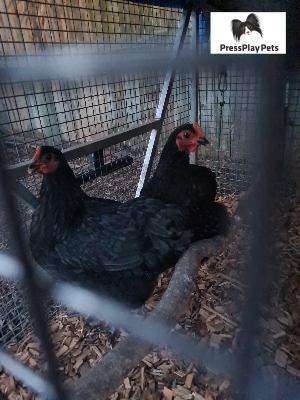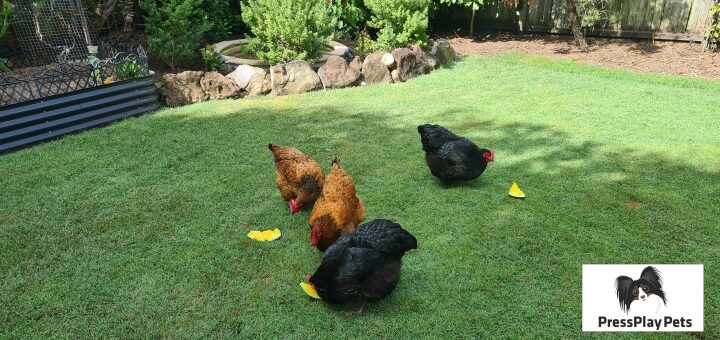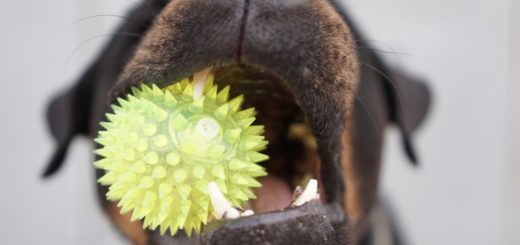A few months ago, we lost our beautiful Pearl to heat stroke. We were devastated. It was the first hen we have ever lost. It was not just us who were devastated, Violet and Grace were struggling with this sudden change in dynamic, they became reluctant to go into their coop at night, looking around and calling out for Pearl.
It took a few weeks for both girls to realise Pearl was gone, forever, slowly they returned to their usual routine. During this time, we gave serious thought on adding, or not, hens to the current “flock”, but were not sure how to go about introducing new hens safely.
After many hours scrolling the internet, watching YouTube, reading blog posts by chicken experts and “picking the brains” of as many chicken people as I could. We discovered two things.
1. Seemingly sweet hens do turn into murderous mean girls.
2. Nearly all videos and blogs were of owners that have one or multiple very large chicken coups with massive built-in runs, and nearly all were on acreage with a large flock.
We really wanted to “reduce” the level of fighting by creating a gentler introduction. But was that even possible? I know, I know I have heard it many times before, the “pecking order”. A natural process that all chickens must go through. Sure, I get it, however it is not nice to witness and can cause serious injury or even death!
It was really becoming difficult to imagine implementing many of the suggestions because we did not have a large flock let alone a large coup and run. Here are the top 10, good and some not so good suggestions we discovered:
1. Put the new hens in at night so the resident hens wake up in the morning not realising new girls have joined the flock. Well, given my current two girls WERE the flock, I am pretty sure they will clue on when they all jump out of bed in the morning.
2. Cover the new hens in baby powder so the new hens can’t smell them. How the heck did that suggestion even start? Chickens are smarter than that, so I am pretty sure they would work out they were still chickens!
3. Put the new hens in a crate inside the run of the coop until they get used to each other. In theory a great idea, but was not going to work for us as our chicken coop is tiny. My girls only go in to sleep and free range all day.
4. Buy another chicken coop and do a coop swap in their living arrangements! OK another great idea that would work for many, but we live in suburbia and not on a huge block where we can have multiple chicken coops.
5. Split the yard in two with two rows of fencing 30 cm apart so that the hens can see each other but cannot touch each other. Love it, but same issue as above!
6. Remove the bully hens from the flock. I only have two older hens, so that would essentially be removing the entire flock.
7. Introduce chickens of the same size and weight. We do agree that would help, but what if the new chickens are pullets?
8. Work in pairs. Introduce at least two so one hen is not singled out. This makes complete sense and what we will be doing.
9. Throw them in together and let them fight it out. What the heck!. Nope, NOT doing that! Next…
10. Introduce a larger ratio of young hens to older hens, this will overwhelm the older hens. I would loveeee a large flock, however this is not be possible in our situation as council restrictions limit the number of hens permitted on suburban blocks.
We finally decided to use a combination of some of the ideas we liked above with a little re-jig to suit what we had to work and what we felt was kind for all our girls.
Before we move on, I must introduce you to our two new girls. Ruby and Harriett, 16-week-old black Australorps. I picked this specific breed mainly for temperament. They are extremely gentle and make great backyard pets and are not given to aggression. They are medium-large in size which should make them a perfect match for my dominant and bossy resident girls Grace and Violet, both Rhode Island Red cross Light Sussex.
Moving on, let’s do stocktake on what we had to work with:
2 x bossy adult hens
1 x small chicken coop
1 x large metal dog crate
1 x toddler play pen
1 x unfenced front yard
1 x fenced back yard
1 x fully enclosed garage
The new girls have arrived, but before we can get started on introductions, it was time to isolate!
Isolation:
To be sure that the girls were not harbouring any contagious health issue that could be passed to our older hens. They went into 4 weeks isolation. We set up a movable dog crate in the garage. The girls would sleep at night in the garage (safe from foxes and pythons!) and the crate would be moved to the front yard during the day, so they got fresh air and sunshine.
Slow Introduction:
Week 1: After the girls passed the isolation period, the crate was moved to the backyard for a couple of hours in the late afternoon so that Grace and Violet to start to get familiar with their presence. So far so good!
Week 2: I really wanted to leave the new girls out in the yard for the full day, but I was worried it was too early, and the new girls might get startled with their new surroundings and fly over the fence into the neighbour’s yard, or worse their pool!
To get around this hurdle we simply extended the crated area with a play pen, this would give them greater access to stretch their legs, scratch around and do what chooks do.
Yes we even tried bribery, warm oats to enjoy together!
Week 3: The new girls were ready to graduate to the next level of our slow introduction. We created a makeshift barrier in a larger section of the backyard. Again, this allowed the older girls to approach but could only make contact if the new girls allowed them. When Ruby and Harriet let their guard down, they were dealt a firm whack on the head or tail feathers pulled by Violet and Grace, thankfully so far nothing more serious than that.
Near the end of week 3, Ruby and Harriet began flying over the barrier to be on the same side as Grace and Violet…. Copping another firm whack on the head and even more feathers pulled, they would promptly fly back over the barrier, safe once again away from the “mean girls”.
Were they telling us it was time to move to the next step?
Week 4: We decided to meet them halfway. When the older girls were out free ranging, we started placing the new girls inside the main coop to become familiar where everything was, and the older girls could see them inside “their” coop. Just a few hours at a time, they were not quite ready for sleep overs!
Week 5: The day had finally arrived for the new girls to move in with their two big sisters. We were nervous, and worried all hell would break loose. Deciding it might be best to try at dusk when Violet and Grace were busy getting ready to go to bed. Ruby and Harriet were popped into the coop and a small scuffle broke out. Grace and Violet pushing themselves into the sleeping quarters leaving poor Ruby and Harriet to spend the night out in the run. Thankfully it was Spring and not Winter!

Moving In Day!
Three Months Later:
A healthy pecking order exists, with Grace keeping her title as head chook and Violet her 2IC, all with very minimal disagreements. Ruby and Harriet, now bigger that the others and being true to their breed, do not seem particularly invested in moving up the ranks, content to just happily potter around the yard.
The “us & them” mentality is still going strong although everyone seems happy to co-exist and use each other for warmth at night.
Got to be pleased with that outcome, right?
In Conclusion:
By allowing the new and older girls to determine the pace, it did take longer than we had anticipated.
It was sometimes hard to be patient, and we did at times start to doubt the process, feeling Grace and Violet were never ever going to accept Ruby and Harriett. With that said, I am extremely happy now with the outcome and believe a gentle slow approach to introduction works and did for all of us.
So yes, I would do it this way again, but geez hopefully not for many years to come!
Author Bio: Nikki is pack leader at Pressplay Pets, a blog for the modern age pet parent interested in health & care, news, reviews & personal accounts of unconditional love & at times heartfelt pain of pet parenting. She is also proud mum to cute and cheeky Papillons ‘Amber’ and ‘Indy’!
Follow Pressplay Pets blog:
Pressplay Pets a blog for the modern age pet parent interested in health & care, news, reviews & personal accounts of unconditional love & at times heartfelt pain of pet parenting!
Follow Us!




Doing an amazing job ! So sorry to hear about Pearl! Xxx
Thank you. Was such a terribly sad thing to happen to Pearl. Very very upsetting 🙁